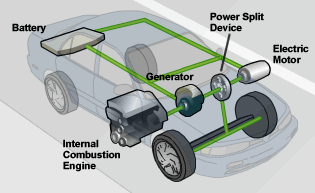 When GM (formerly known as "General Motors") joined with its sister government entity, the EPA (rumored to be some sort of "Environmental Protection" Agency), and announced that its Chevrolet Volt vehicle would get the equivalent of 230 miles to the gallon of gas, many people were highly skeptical of this performance claim.
When GM (formerly known as "General Motors") joined with its sister government entity, the EPA (rumored to be some sort of "Environmental Protection" Agency), and announced that its Chevrolet Volt vehicle would get the equivalent of 230 miles to the gallon of gas, many people were highly skeptical of this performance claim.
They were right to be. Tim Haab, for one, did the math and worked out that this level of mileage corresponded to just a 51.11 mile long trip in the Chevy Volt - the first 40 miles powered by the vehicle's battery, with the remainder provided by the vehicle's 50-MPG gasoline-powered engine, which would consume about 0.22 gallons of gasoline.
Clearly, the insider collaboration between the government's motor vehicle production unit and its environmental regulation enforcement unit has failed to produce a useful measure that consumers can use to reasonably compare the fuel economy performance of alternative fuel and hybrid vehicles.
There's a better way. The organization behind the Progressive Automotive X-Prize has employed a metric known as the Miles-Per-Gallon-Energy Equivalent (MPGe) specifically to compare the fuel economy of alternative-fuel powered and hybrid vehicles. Better yet, they've posted a spreadsheet for doing the necessary math to compare the fuel economy of these kinds of vehicles with respect to ones just powered by gasoline, with which most consumers are familiar.
And now there's us. We've adapted the X-prize's spreadsheet calculator into an easier to use online tool, one that allows you to find the MPGe of a vehicle that is powered just by gasoline or an alternative fuel or a hybrid that uses any two of the common conventional or alternative fuel technologies in development today. Select the fuel type in the tool below and we'll find the comparable fuel economy metric for the fuel consumed and travel distance you also enter.
The default values we've provided in the tool above are those we've found for the Chevy Volt, taking the distance Tim Haab found to correspond with the 230 MPG figure, with the amount of gasoline used we found earlier in this post that corresponds to that figure as well as the energy capacity of the vehicle's lithium ion batteries, which are assumed to be fully expended in the vehicle's first 40 miles of driving.
At the resulting 74 MPGe, the Chevrolet Volt is much less impressive than the government-owned carmaker and environmental agency would have us believe.
More About the Results and a Quick Guide to Abbreviations
The results in the tool above are given with respect to gasoline as the energy equivalent. In the notes for their spreadsheet, the automotive X-prize people indicate that the units of fuel used is "the amount of fuel delivered from the pump (or plug) to the vehicle." They also state that "in the case of electricity, this is measured from the wall plug - i.e., prior to any losses incurred during battery charging."
The units "kWh" for Electricity stand for "kilowatt hours". The units "SCF" for H2-Gas and H2-Liquid are "Standard Cubic Feet". E85 is a gasoline-ethanol mixture, which is 85% ethanol/15% gasoline. "CNG" stands for "Compressed Natural Gas", while "LPG" is "Liquified Petroleum Gas" and "H2" indicates "Hydrogen".
Previously on Political Calculations
Labels: environment, tool
Welcome to the blogosphere's toolchest! Here, unlike other blogs dedicated to analyzing current events, we create easy-to-use, simple tools to do the math related to them so you can get in on the action too! If you would like to learn more about these tools, or if you would like to contribute ideas to develop for this blog, please e-mail us at:
ironman at politicalcalculations
Thanks in advance!
Closing values for previous trading day.
This site is primarily powered by:
CSS Validation
RSS Site Feed
JavaScript
The tools on this site are built using JavaScript. If you would like to learn more, one of the best free resources on the web is available at W3Schools.com.